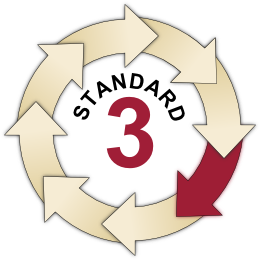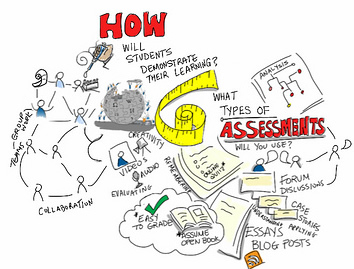Assessment is an ongoing process used to discover what, how, when, and which students learn with regard to expected learning outcomes.
Assessments, if done effectively, provide the instructor with a view of how well students are doing and whether or not they are meeting planned objectives. Feedback can help students and teachers alter a course of action, and make more favorable learning decisions. In addition, assessment will help your students gain insight into their level of content understanding and help individualize learning to their needs.
Assessment in the Backward Design Process
Using the principle of backward design, you can align your assessment directly to the learning objectives. First, we want to know:
Stage 1: What is worthy and requiring of understanding? These are the course and unit/module/week objectives you developed in the last module.

Now we are moving to Stage 2: What is evidence of understanding? These are the assessments of student learning to develop for this module.
Specifically:
-
What evidence will demonstrate that students have mastered the objectives or completed the problem?
-
What will, or should they be able to do to give evidence of mastery?
-
How will you articulate and communicate parameters for different gradations of skills or mastery (e.g., in a rubric that delineates acceptable and unacceptable levels; or developing, satisfactory and mastery levels)?
There are many ways to assess student learning online. In a face-to-face course, you can often gauge understanding and learning by looking for puzzled looks, lack of response to questions, students catching the instructor in the hall with questions, and at the quality of students’ participation in group activities. Since these less formal interactions are difficult to replicate online, a variety of assessment methods need to be incorporated.
Online, students learn by completing assessments and points or grades are assigned to these activities. Therefore, online assessments serve a dual purpose: to help students learn content and to assess learning. That is why you will find discussion forums, case studies, problem-based learning, classroom assessment techniques, and other methods listed in both the assessment and content units of this course.
Characteristics of an Exemplary Learning Assessment |
|---|
Authentic – reflects real life experiences Challenging – stimulates the learner to apply knowledge Coherent – serves as a guide for the learner to achieve the learning goal Engaging – attracts the learner’s interest Respectful – is sensitive to the individual learner’s beliefs and values Responsive – includes a feedback mechanism to assist the learner in the learning process Rigorous – requires applied understanding of learning to achieve a successful outcome Valid – provides information that guides the learner toward meeting the intended learning outcomes |
Source: http://jolt.merlot.org/vol6no1/sewell_0310.htm
Several themes underlie assessments (Dereshiwsky, 2001):
- Many principles of good assessment practice apply equally to online, face-to-face, or blended classrooms where the aim of assessment should be to foster student learning and performance mastery.
- Most classroom assessment methods can be adapted for use online, where tools are available to support quizzes or exams, discussions, papers, projects, portfolios, and other individual or group assignments.
- The online environment enables creative assessment formats that utilize the Internet—some examples will be shared later in this module. The online environment can also facilitate timely and efficient feedback to students through online feedback forms, embedded comments, self-check quizzes, drag-and-drop games, gradebooks, and other tools.
- Adequate support must be provided to students and faculty to prepare them for the online environment and the use of technology for assessment.
Reference: Dereshiwsky, M. I. (2001). 'A' Is for Assessment: Identifying online assessment practices & perceptions. Education at a Distance, 15(10).
Quality Matters™ Standard 3: Assessment & Measurement
 Assessments are integral to the learning process and are designed to evaluate learner progress in achieving the stated learning objectives or mastering the competencies.
Assessments are integral to the learning process and are designed to evaluate learner progress in achieving the stated learning objectives or mastering the competencies.
Assessments should be implemented in a manner that corresponds to the course learning objectives or competencies, and they should not only allow the instructor a broad perspective on the learners' mastery of content but also allow learners to track their learning progress throughout the course.
The following Quality Matters™ specific standards provide a good checklist for course assessments:
3.1 The assessments measure the achievement of the stated learning objectives or competencies.
3.2 The course grading policy is stated clearly at the beginning of the course.
3.3 Specific and descriptive criteria are provided for the evaluation of learners’ work, and their connection to the course grading policy is clearly explained.
3.4 The assessments used are sequenced, varied, and suited to the level of the course.
3.5 The course provides learners with multiple opportunities to track their learning progress with timely feedback.
Full Annotated Rubric: Quality Matters General Standard 3: Assessment and Measurement
Source: Quality Matters™ Rubric Standards with Assigned Point Values
Reprinted with permission. Copyright © 2018 by MarylandOnline, Inc. All rights reserved.
General Standard 3: Assessment and Measurement prompts instructors to take a close look at the assessment and ways of measuring learning objectives or competencies in the course. Quality Matters™ stresses the importance of "measurable" objectives or competencies so these learning objectives or competencies can guide instructors to develop assessments that accurately assess learner accomplishment.
For example, a learning objective or competency that states learners will "understand modern art" cannot be measured as there is no way to adequately define and then assess a learner's understanding. However, a learning objective or competency that states learners will "describe the five characteristics of paintings classified as modern art" is something that can be measured through a variety of assessment techniques.
The terms "assessment" and "measurement" used in General Standard 3 mean more than just quizzes and exams. "Assessment" refers to any learner activity for which the instructor provides feedback that guides the learner to improve learning. Assessment activities might range from a brief, automatically-graded self-check to a fully annotated paper to a final essay exam; each is important because it helps the instructor form an accurate, current picture of the learners' knowledge and provides crucial, regular feedback to help learners assess their progress.
It is best to use several different kinds of measures to assess student learning. Individuals learn and can best demonstrate their learning in different ways. Furthermore, the assessment method used should correspond with the knowledge or skill being measured.
Suggested Readings & Resources:
-
Bloom’s Taxonomy Process Verbs, Assessments, and Questioning Strategies
-
9 Principles of Good Practice for Assessing Student Learning. Source: American Association for Higher Education, Assessment (now the American Association for Higher Education and Accreditation)
